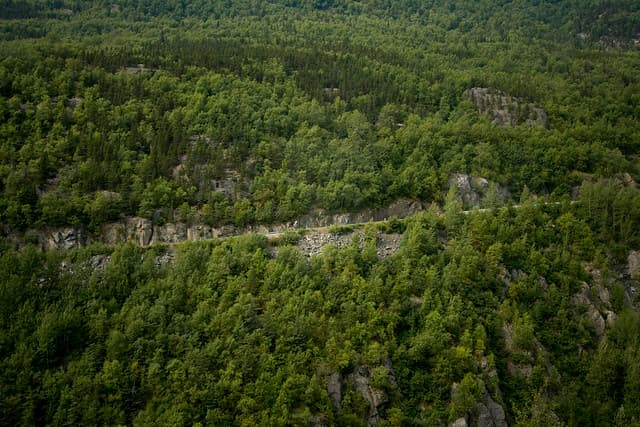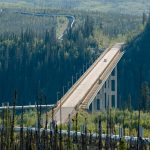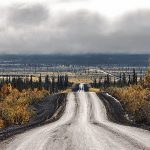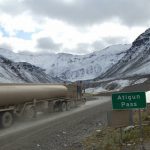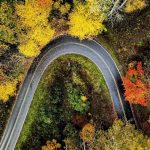The Klondike Highway (also known as Alaska Route 98 in Alaska and Yukon Highway 2 in Yukon) is a scenic road located in the Yukon territory, Canada. It connects the cities of Skagway in Alaska with Dawson City in Yukon, Canada. The highway spans approximately 715 kilometers (444 miles) and can be traveled in about 10 hours. It passes through spectacular landscapes, offering travelers the opportunity to explore a region rich in history and natural beauty.
- Location: Alaska (USA) and Yukon and British Columbia (Canada)
- Lenght: 715 kilometers (444 miles)
- Highway: Alaska Route 98 in Alaska and Highway 2 in British Columbia and Yukon
- North and South end: Skagway, AK and Dawson City, YT

Dawson City, Arthur Chapman
The Klondike Highway begins in Skagway, a port city in southeastern Alaska known for its connection to the Klondike Gold Rush in the 1890s. From Skagway, the road winds into the Coast Mountains, passing through mountainous landscapes, forests, and picturesque rivers. Finally, the highway reaches its final destination, in Yukon, a historic and vibrant city.
The Klondike Highway starts at the port of Skagway, where the southern end of the road is located, traversing Alaska for just 24 kilometers before reaching the Canadian border. From there, the highway crosses stunning mountainous landscapes while crossing the border between Alaska and Canada. It then continues north along the Yukon River valley until it reaches Whitehorse, where the Klondike Highway and the Alaska Highway merge into a single road and travel together for a few kilometers.
From Skagway to Dawson City: Points of Interest of the Klondike Highway
Along the Klondike Highway, there are several points of interest and popular stops for travelers. Some of them include:
- Carcross: A small town with a rich history in the Klondike Gold Rush. Here, you can visit the White Pass Railroad Museum and enjoy outdoor activities such as hiking and kayaking.
- Skagway National Historic Park: Located in Skagway, this park preserves buildings and the history of the Klondike Gold Rush, offering a fascinating glimpse into that historical period.
- Klondike National Park and Historic Reserve: This park provides an opportunity to explore historical sites related to the Klondike Gold Rush, such as the discovery site of gold on Bonanza Creek.
- Emerald Lake: A beautiful emerald-colored lake surrounded by mountains. It is a popular spot for photography and enjoying the tranquility of the natural surroundings.
- Yukon River: Along the highway, travelers will cross the majestic Yukon River, one of the longest rivers in North America. Its scenic beauty is impressive and offers opportunities for water sports, fishing, and wildlife observation.

The Klondike Highway as it passes through the city of Whitehorse, in Yukon
What is the best and worst time of year to drive the Klondike Highway?
The best time to travel the Klondike Highway is during the summer months, from May to September, when the roads are in better condition and most points of interest are open. However, even during the summer, it is essential to be prepared for sudden weather changes and to carry appropriate clothing, food, and extra water.
Precautions and tips to drive the Klondike
Although the Klondike Highway is a well-maintained road, especially during the sum
mer months, there are certain difficulties that drivers may encounter, particularly in the winter months. During winter, weather conditions can become extreme, with heavy snowfall and very low temperatures, making driving hazardous as the road may be covered in snow and ice, requiring winter driving skills.
Additionally, the highway passes through mountainous terrain, involving steep slopes and tight curves, as well as remote areas where services may be limited, so it’s important to carry essential supplies and be prepared for emergency situations. Extra caution is recommended when driving and being prepared for changing conditions.
- Fill up your gas tank: Make sure to have a full gas tank before starting your journey. The Klondike Highway passes through remote areas where gas stations may be scarce, so it’s essential to have enough fuel for the entire trip.
- Bring food and water: As mentioned, it’s advisable to carry enough food and water for the journey. Although there are some places along the highway where you can find food, it’s best to be prepared just in case. Pack non-perishable food items and ensure you have enough drinking water to stay hydrated.
- Don’t rush: The Klondike Highway is a scenic and beautiful road, but it’s important to drive with caution and respect speed limits. The sharp curves, steep slopes, and abrupt changes in road conditions require careful driving. Maintain an appropriate speed and stay attentive to traffic signs.
Spare tire: Carrying a spare tire is essential as there may be unpredictable road conditions. Make sure your spare tire is in good condition and that you have the necessary tools to change it in case of a puncture. - No mobile coverage: Be aware that there may be areas along the Klondike Highway with no mobile coverage. You may not be able to make phone calls or access the internet in certain stretches of the road. Make sure to inform someone about your itinerary and have a contingency plan in case of an emergency.
- Check weather conditions and road updates before setting off. Stay informed about possible road closures or hazardous conditions. Driving with caution, respecting traffic rules, and being prepared for any eventuality will ensure a safer and more enjoyable journey on the Klondike Highway.
History
The construction of the Klondike Highway was undertaken to provide a safer and more accessible route during the Klondike Gold Rush. During the 1890s, thousands of gold seekers arrived in the region in search of fortune, and the need for a reliable transportation route became evident. The road was initially built as a trail for dog sleds and was later improved and paved to accommodate motor vehicles.
The construction of the Klondike Highway took place in the 1950s as an alternate route to access Yukon territory from Alaska. Before its construction, the only way to reach Yukon from the south was through the White Pass Railroad and the Chilkoot Trail. The highway has had a significant impact on the region, facilitating the transportation of goods and people between Alaska and Yukon. It has driven economic development and tourism in the region by providing access to stunning mountain landscapes and historical sites related to the gold rush.
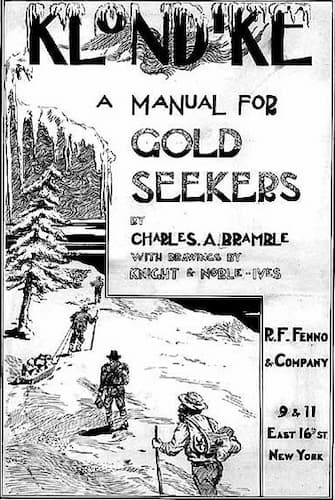
Gold Seekers Guide
Klondike Gold Rush
The Klondike Gold Rush was a significant historical period in the gold rush that took place in the Klondike region, located in the Yukon territory in Canada. The Klondike Gold Rush began in August 1896 when gold nuggets were found in Bonanza Creek, a tributary of the Klondike River. The news of the discovery spread rapidly and attracted a crowd of gold seekers from around the world. Thousands of people, mainly from the United States and Canada but also from Europe and other parts of the world, headed north in search of fortune and the hope of finding gold.
Once gold seekers arrived in Klondike, they had to establish camps and start searching for gold in riverbeds and streams. As more and more people arrived in the region, easily accessible gold mining spots quickly became depleted. This led to intense competition and struggles for mining rights.
It is estimated that around 100,000 gold seekers traveled to Klondike during the gold rush, but only a few thousand succeeded in their search. Many faced difficult conditions such as disease, famine, and freezing temperatures. Additionally, commercial enterprises set exorbitant prices for necessary supplies, further adding to the hardships for gold seekers.
It is estimated that around 12 million ounces of gold were extracted during the Klondike Gold Rush, with an approximate value of $500 million at that time. This gold rush had a significant impact on the Klondike region and the Canadian economy as a whole. The Klondike Gold Rush left a lasting legacy in the history of exploration and mining in western Canada. It also became a recurring theme in literature, music, and film, with iconic stories such as Jack London’s “The Call of the Wild.”
Klondike Highway in Google Maps
Featured image: Boris Kasimov


 (4 votes, average: 4.00 out of 5)
(4 votes, average: 4.00 out of 5)
